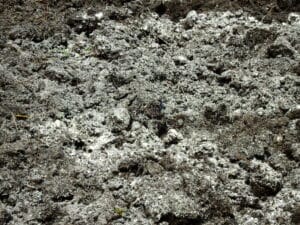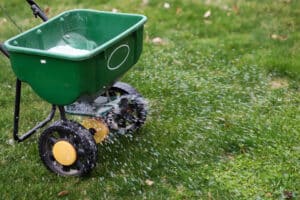Walking through your yard and finding your shoes covered in orange or brown dust likely means your lawn has grass rust. This fungus can make your grass look under the weather, but it’s not too hard to fix. Understanding grass rust helps in tackling it effectively. The fungi causing this condition thrive in warm, humid environments, often popping up in mid-summer and early autumn.
Identifying grass rust means creating an action plan, which typically involves mowing, fertilizing, watering, and seeding. Combining treatments can prevent grass rust from progressing in the first place. We’ll break down what grass rust is and how to handle it, then recommend some top lawn care services to keep your turf looking its best.
Find Lawn Help
- See our list of top lawn care companies based on in-depth research.
- Select the company that best meets your needs.
- Get a free, no-obligation quote for your home.
Get a Quote From Lawn Professionals Near You
Compare quotes from local pros

Lime Soil Amendment

Lawn Fertilization
What Is Grass Rust and What Causes It?
Grass rust is not a single lawn disease but rather a name for several species of fungus called Puccinia or Uromyces. The yellowish-orange dots that you see on grass blades are actually the spores of this fungus, which is how it reproduces.
The fungus spreads when animals or humans pick up the spores on the skin, fur, or clothing and move them to an uninfected location. Although spores need to be present for the infection to start, certain weather conditions make this fungal disease much more likely.
Lawn rust is most likely to develop in the summer or early fall when temperatures are warm and humidity is high. According to the University of Illinois Extension Agriculture Program, here are some specific conditions that contribute to the growth of rust fungus:
- A season of excessive, heavy rain that depletes soil nitrogen
- Cool nights with heavy dew and frequent rainfall
- Cloudy, humid weather followed by hot, sunny weather
- Low soil nitrogen and low water availability that lead to slow growth
What Is the Impact of Grass Rust on Lawn Health?
Grass rust damages your lawn by weakening individual grass blades and disrupting overall lawn health. The fungus coats the blades with orange or yellowish spores, blocking photosynthesis and reducing the plant’s ability to produce food. As a result, the affected areas may appear thin, patchy, or dull in color. Grass rust also increases the lawn’s susceptibility to drought and other stressors, which leads to further decline in health if left untreated.
Over time, untreated grass rust can compromise your lawn’s density and resilience. Weak turf struggles to recover from mowing, foot traffic, and harsh weather conditions. In some cases, the disease allows more aggressive weeds or pests to invade, forcing homeowners to invest more time and money into recovery. By recognizing the early signs and acting quickly, you can minimize the long-term damage and restore your lawn’s health more effectively.
What Are the Signs and Symptoms of Grass Rust?
The symptom of rust diseases that you’re most likely to spot is the obvious one—small, yellow dots on grass blades that develop into orange or brown pustules.
When touched, these pustules rupture easily and spread a powdery substance that’s a rusty orange in color. The individual grass blades will begin to look thin and weak, breaking more easily.

Bermuda grass, Kentucky bluegrass, perennial ryegrass, and tall fescue are all susceptible to developing grass rust. Although this lawn fungus typically won’t kill the infected turfgrass, it will weaken the grass, leaving it less able to photosynthesize and withstand damage or other lawn diseases.
Can You Prevent Grass Rust?
The best way to prevent lawn rust is to invest in its general health. A robust, healthy lawn is better able to fend off all types of grass disease, and regular lawn care is a big part of the equation.
Know what species of turfgrass you have and how it responds to changing seasons throughout the year. Mow regularly, setting your lawn mower to cut off no more than one-third of the blades at a time, keeping stress on the grass to a minimum.
Quick Tip
- Proper fertilizing is also a key part of the process. Insufficient soil nitrogen can weaken turfgrass, leaving it susceptible to disease. However, huge influxes of nitrogen can cause quick overgrowth, which then depletes the grass’s resources and also leaves it weaker. Steady, seasonal fertilizing customized to your soil and turfgrass’ needs gives it the best chance to fight off grass rust.
Determine whether your lawn contains cool-season grass like tall or fine fescue or Kentucky bluegrass, or a warm-season species like Bermuda grass or zoysia grass. Cool-season grasses go dormant in the heat of summer and hit their growing season when temperatures begin to cool off in the fall. Warm-season grasses, on the other hand, grow fastest in the spring and early summer but go dormant in the winter.
Fertilize each type of grass as it begins its growing season—that means the early fall for cool-season grasses and the spring for warm-season grasses.
How To Treat Grass Rust
Fortunately, you typically don’t need fungicides to treat rust-infested grass. Usually, some intensive lawn maintenance will get rid of rust in your lawn. Learn more about the steps to treating grass rust in the dropdown sections below:
Step 1: Reduce Lawn Moisture
First, you typically want to reduce moisture levels that are allowing the fungus to flourish, so hold off on watering your lawn until the grass needs it instead of relying on automatic sprinklers. Deep but infrequent watering is better for your lawn than frequent, shallow irrigation. Additionally, water the lawn in the morning to let it dry out during the day.
Step 2: Fertilize the Lawn
Next, fertilize the lawn with a high-nitrogen fertilizer, preferably a slow-release formula that will keep nitrogen levels steady over a longer period. Don’t go overboard in the late fall, though, since warm-season grasses are about to go dormant for the winter, and cool-season grasses suspend their growth. You may want to wait out the winter if it’s later than September or October. Chances are that the fungus will die out in the cold.
Step 3: Continue Preventive Maintenance
Keep mowing regularly, but make sure to bag grass clippings instead of letting them scatter, which can actually spread the rust further.
Lawn aeration can help as well, since it reduces soil compaction and improves drainage. If your grass is a species that produces thatch, performing a gentle dethatching will help improve air circulation around the grass, preventing it from holding on to too much moisture.
Finally, prune back trees and shrubs as much as possible to increase sunlight and air circulation for your grass.
When To Call in the Pros
Although fungicides aren’t usually necessary, the types of fungicides that are effective against lawn rust typically aren’t available to consumers. You’ll need to call a professional and have them apply the substance to your lawn.
However, this should only be used as a last resort because some fungicides can damage grass. If you consult a professional about lawn rust, they’ll help you create a fertilizing and maintenance plan that will strengthen your grass and fight off the fungus naturally.
Our Top Picks for Professional Lawn Care
Luckily, there are plenty of good options for professional lawn care providers. Our first choice is TruGreen, a nationwide company that specializes in customizing fertilizer, aeration, and weed control to your lawn’s needs. Every treatment plan begins with an analysis of the soil, and every plan comes with a Healthy Lawn Guarantee. TruGreen’s technicians can even provide lime treatments and some tree and shrub care.
Our Conclusion
Removing lawn rust is vital for maintaining a healthy and lush lawn. You can manage and prevent this fungal disease by improving irrigation, fertilizing appropriately, and encouraging air circulation. Choosing resistant grass types and practicing regular lawn maintenance strengthens your turf, helping it resist future outbreaks. These strategies ensure that your yard stays lush and visually appealing throughout the growing season.
Stay proactive by watching for early signs of discoloration and addressing lawn stressors right away. Consistent care allows your grass to recover quickly and reduces the chances of recurrence. If you find the problem overwhelming or persistent, professional lawn care services can offer targeted treatments and long-term solutions to keep your lawn in top shape.
FAQs About Identifying and Removing Grass Rust
Is grass rust harmful to people or pets?
No, the fungus that causes grass rust won’t harm you, your kids, or your pets. However, a child or dog who plays in a yard full of grass rust will probably need a good rinse-off before coming inside. The brightly colored rust spores could stain carpets.
Will lawn rust go away on its own?
Depending on the severity of the infection, it might, but you’ll probably have to wait through the winter for it to happen. A quicker solution is putting down a bit of fertilizer and reducing excess soil moisture.
Will rust fungus kill my grass?
The fungus that causes lawn rust needs a living host to survive, so no, lawn rust alone typically won’t kill your grass. The problem is largely one of appearance. However, it will weaken the grass, making it more susceptible to drought, damage, and other diseases.
What’s the difference between red thread and lawn rust?
Both grass rust and red thread are lawn diseases caused by a fungus, and they both tend to affect the same kinds of turfgrasses.
However, grass rust produces a yellow, orange, or brown powder that will come off on your shoes as you walk through your lawn. Red thread, on the other hand, will cause isolated patches of brown, dying grass, and if you look closely, you’ll be able to see red or pink fungal threads. Additionally, red thread tends to affect lawns during mild spring weather, whereas lawn rust prefers the warm, humid weather of summer and early fall.

